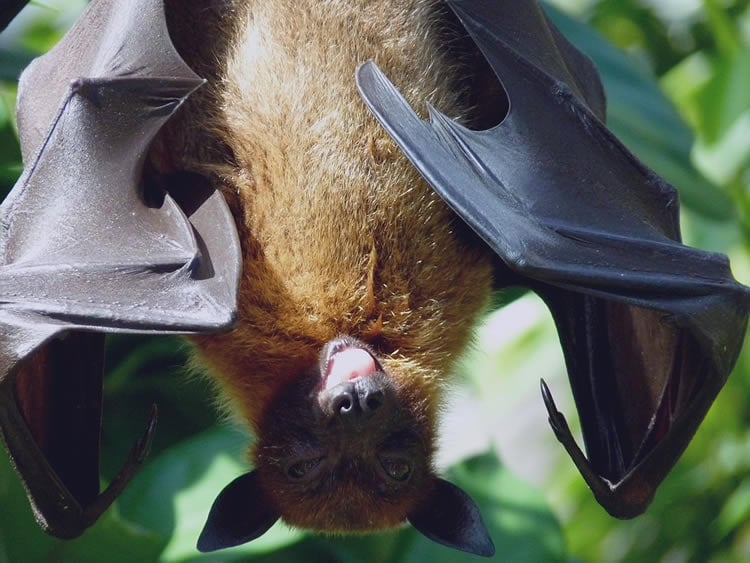Summary: Rather than being born with a fixed set of communication skills, bats learn how to communicate, a new study reports.
Source: AFTAU.
Analyzing some 15,000 bat vocalizations, Tel Aviv University researchers identify speakers, objectives and contexts of bat conversations.
Bats, like humans, are extremely social mammals. They enjoy an average lifespan of 20-30 years, settle in large colonies, and rely heavily on social interactions for their survival, using vocalizations — or calls — for communication. There is very little known about the purpose and content of these noises.
A new Tel Aviv University study published in Scientific Reports extracts critical information from bat vocalizations to offer a rare, informative look into the world of bat communication. The new research, led by Prof. Yossi Yovel of the Department of Zoology at TAU’s Faculty of Life Sciences, delves into the veritable cacophony emitted by bats to identify concrete evidence of a socially sophisticated species that learns communication, rather than being born with a fixed set of communication skills.
“When you enter a bat cave, you hear a lot of ‘gibberish,’ a cacophony of aggressive bat noise – but is this merely ‘shouting’ or is there information amid the noise?” said Prof. Yovel. “Previous research presumed that most bat communication was based on screaming and shouting. We wanted to know how much information was actually conveyed — and we wanted to see if we could, in fact, extract that information.”
For the purpose of the research, Mor Taub and Yosef Prat, students in Prof. Yovel’s lab, recorded the sounds emitted by 22 Egyptian fruit bats in TAU’s “bat cave” over the course of 75 days. The authors then assembled a dataset of approximately 15,000 vocalizations, which represented the full vocal repertoire the bats used during the experiment. By analyzing this dataset, the authors found that the vocalizations contained information about the identity of the bat emitting the call and even about the identity of the bat being addressed by the call. Moreover, while most of this species’ vocalizations were emitted during aggressive encounters, by analyzing the spectral composition of the calls, the authors were also able to distinguish their specific aggressive context (such as squabbling over food, sleeping spots or other resources).
“Studying how much information is conveyed in animal communication is important if you’re interested in the evolution of human language,” said Prof. Yovel. “Specifically, one big unknown in the world of animal communication is their grasp on semanticity — i.e., when you hear the word ‘apple’ you immediately imagine a round, red fruit. We found, in our research, that bat calls contain information about the identities of the caller and the addressee, which implies that there is a recognition factor. We were also able to discern the purpose and the context of the conversation, as well as the possible outcome of the ‘discussion.'”

Due to the difficulty of cataloguing animal calls, these vocalizations are often grouped into one category in acoustic studies. According to Prof. Yovel, the new findings suggest that delving into animal calls could serve a bigger purpose, shedding light on the evolution of communication altogether.
“We generated a massive amount of data — dozens of calls over three months,” said Prof. Yovel. “We have found that bats fight over sleeping positions, over mating, over food or just for the sake of fighting. To our surprise, we were able to differentiate between all of these contexts in complete darkness, and we are confident bats themselves are able to identify even more information and with greater accuracy — they are, after all, an extremely social species that live with the same neighbors for dozens of years.”
The researchers were even able to identify different intonations indicating the greetings of a “friend” or a “foe.”
“The last finding allowed us to predict whether the two would stay together or part, whether the interaction would end well or badly,” said Prof. Yovel, who is currently researching different bat accents and the assimilation of bats into different social groups.
Source: George Hunka – AFTAU
Image Source: NeuroscienceNews image is in the public domain.
Original Research: Full open access research for “Everyday bat vocalizations contain information about emitter, addressee, context, and behavior” by Yosef Prat, Mor Taub & Yossi Yovel in Scientific Reports. Published online November 22 2016 doi:10.1038/srep39419
[cbtabs][cbtab title=”MLA”]AFTAU “Bat Calls Contain Wealth of Discernible Information.” NeuroscienceNews. NeuroscienceNews, 30 December 2016.
<https://neurosciencenews.com/bat-vocalization-neuroscience-5837/>.[/cbtab][cbtab title=”APA”]AFTAU (2016, December 30). Bat Calls Contain Wealth of Discernible Information. NeuroscienceNew. Retrieved December 30, 2016 from https://neurosciencenews.com/bat-vocalization-neuroscience-5837/[/cbtab][cbtab title=”Chicago”]AFTAU “Bat Calls Contain Wealth of Discernible Information.” https://neurosciencenews.com/bat-vocalization-neuroscience-5837/ (accessed December 30, 2016).[/cbtab][/cbtabs]
Abstract
Everyday bat vocalizations contain information about emitter, addressee, context, and behavior
Animal vocal communication is often diverse and structured. Yet, the information concealed in animal vocalizations remains elusive. Several studies have shown that animal calls convey information about their emitter and the context. Often, these studies focus on specific types of calls, as it is rarely possible to probe an entire vocal repertoire at once. In this study, we continuously monitored Egyptian fruit bats for months, recording audio and video around-the-clock. We analyzed almost 15,000 vocalizations, which accompanied the everyday interactions of the bats, and were all directed toward specific individuals, rather than broadcast. We found that bat vocalizations carry ample information about the identity of the emitter, the context of the call, the behavioral response to the call, and even the call’s addressee. Our results underline the importance of studying the mundane, pairwise, directed, vocal interactions of animals.
“Everyday bat vocalizations contain information about emitter, addressee, context, and behavior” by Yosef Prat, Mor Taub & Yossi Yovel in Scientific Reports. Published online November 22 2016 doi:10.1038/srep39419






